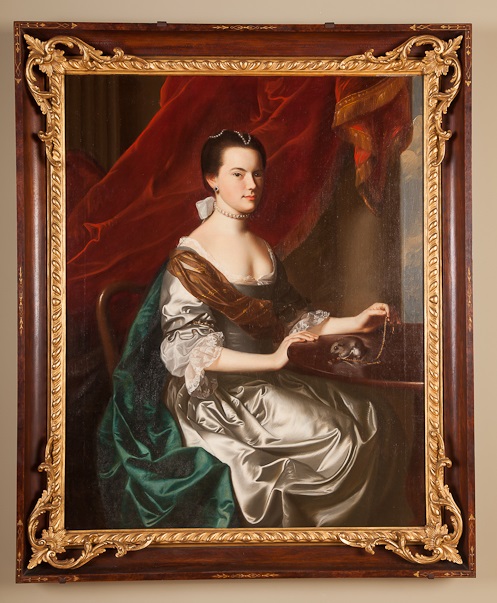
John Singleton Copley, (1738 – 1815)
Mrs. Theodore Atkinson, Jr. (Frances Deering Wentworth), 1765
Crystal Btridges Museum of American Art, Bentonville, Arkansas
Oil on canvas
The frames on the paintings in Crystal Bridges’ permanent collection are a subject of great interest to Museum guests. Many times the antique, ornate frames are nearly as beautiful as the artworks they display. And sometimes the frame provides interesting clues to the history of the work.
One frame in particular tells an interesting story: the one surrounding John Singleton Copley’s portrait of Mrs. Theodore Atkinson, Jr., on view in the Colonial to Early Nineteenth-Century Art Gallery.

John Singleton Copley, 1738 – 1815
“Mrs. Theodore Atkinson Jr. (Frances Deering Wentworth)”, 1765
Oil on canvas
This work boasts not one frame, but two: first, a highly ornate gilded frame that is possibly the original, or at least contemporary with the work, which was painted in 1765. Around this is a much simpler shadowbox frame that dates from a later period: around the 1880s, some 120 years after the painting was made.
Before the work was installed at Crystal Bridges, curators debated whether or not to keep the additional shadowbox. On one hand, as a later addition, it was a clearly not part of the artist’s original intention. But on the other, the dual frame had clearly been a part of the work for many years and had become, in a way, a bit of the history of the painting.
In the end the curators decided to keep both frames. Then-curator Kevin Murphy explained it this way: “It shows how the meaning of an artwork changes over time. Originally, that portrait would have served as a mark of who Mrs. Atkinson was, her status. But by the 1880s there was a sacralization of art. It’s when art began to be considered high art, separate from the regular world. And that’s when the shadowbox was put around the frame. It moves the artwork from being a functional object to being a precious object. Mrs. Atkinson as a person becomes less important than the fact that it’s a painting by John Singleton Copley, and a spectacular example of his work.”
Not all the frames on old paintings in the collection are themselves antiques. eighteenth- and nineteenth-century frames in excellent condition are not easy to come by, so sometimes paintings are framed with appropriate reproductions. Think you can tell a genuine antique frame from a modern reproduction?
We’re also pleased to announce that the Museum will begin offering an all-new drop-in Frames Tour beginning in April.




